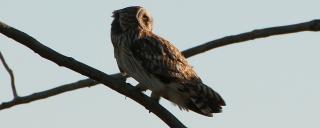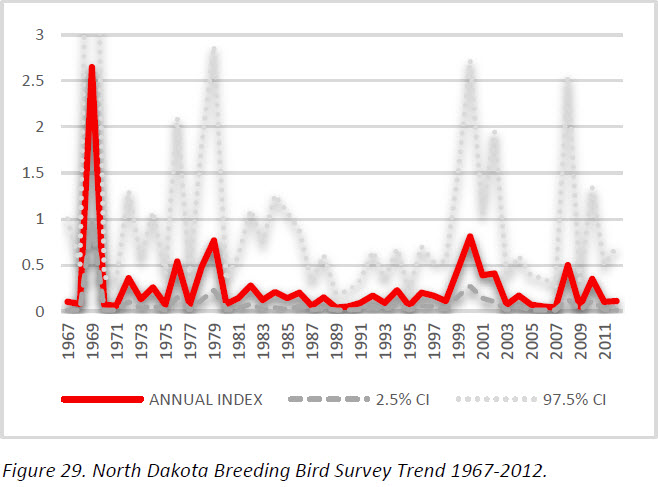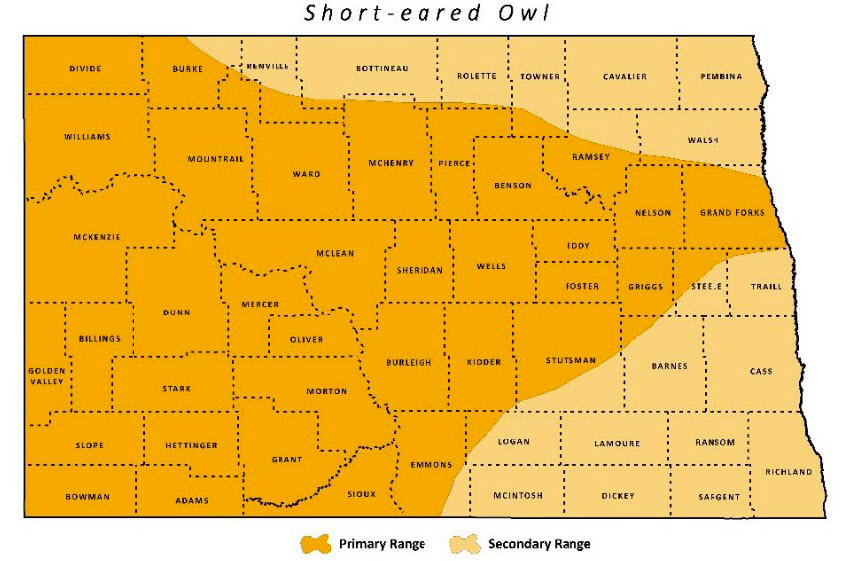
Short-eared Owl
| Scientific Name | Asio flammeus |
|---|---|
| General Description | L 15”, WS 38”, 12 oz. Yellowish-brown, spotted back and subtle ear tufts on a large round head. |
| Status | Year-round, some are migratory. Peak breeding season late April to mid-July. |
| Abundance | Fairly common to uncommon. |
| Primary Habitat | Open grasslands, native prairie, wet meadows, or hayfields. |
| Federal Status | Migratory Bird. |
| Reason for Designation | Long-term, range-wide declining trend. It is included on the National USFWS Birds of Conservation Concern list, and also in Region 6, BCR 11 and 17, Partners in Flight (PIF) identifies the Shorteared Owl as a Regional Concern Species and a Common Bird in Steep Decline. |
Locations and Conditions of Key Habitat
Preferred Habitat
Short-eared Owls are found in large expanse of open grassland and wetland areas. An area of >100 ha of grassland is likely required for successful production. Native prairie, hayland, retired cropland, small-grain stubble, shrub-steppe, and wet meadow zones of wetlands are utilized. Nest on the ground in dry uplands. Nesting vegetation is generally 30-60 cm high with 2-8 years of accumulated residual vegetation. Primary prey includes small mammals, particularly Microtus voles.
Key Areas and Conditions for Short-eared Owl in North Dakota
No specific sites have been identified. CRP grassland is important habitat for Short-eared Owls. Populations fluctuate yearly due to variation in small mammal populations and the nomadic nature of the species.
Problems Which May Affect this Species
Habitat
Conversion of grassland to cropland, energy development and urban expansion. Degradation of grasslands from invasive plants, woody encroachment, succession, and loss of diversity. The loss of CRP in particular will limit nesting habitat.
Other Natural or Manmade Factors
Human induced declines of prey abundance. Illegal killing by poachers may occur. Early haying or mowing could destroy nest or young birds. Collisions with man-made structures and vehicles occur.
Research and Survey Efforts
Current Research or Surveys
- Nothing at this time.
Previous Research or Surveys
- Ducks Unlimited (ND SWG T-3-1 and T-8-R) determined demographic performance of prairie-nesting shorebirds and raptors in North Dakota. The project was initiated in 2004 and a final report provided in 2007. The highest reproductive success for Short-eared Owl was in those areas with large amount of wetland area and native grassland, and wetland habitat that has dense nesting cover. Preserving large intact grassland/wetland landscapes are key to safeguarding populations of Short-eared Owls (Stephens and Walker 2007).
Additional Research or Surveys Needed
- Further explore demographic parameters between landscapes.
- Lack of adequate understanding of small mammal population dynamics and management strategies for them, and how this affects owl populations.
- Temporal and spatial variation in owl movements.
Population and Trend Estimates

- PIF Global Population Estimate: 3,000,000
- PIF North American Population Estimate: 600,000
- PIF North Dakota Population Estimate: 19,000
- North Dakota BBS Trend: see figure 29
- Survey-wide BBS Trend 1966-2012: -2.48
Management Recommendations
- Create and protect large, open areas of a mosaic of grasslands and wetlands.
- Periodically burn, mow, or graze to maintain 2-8 year old accumulations of residual vegetation.
- In tallgrass prairie, burn, mow, or graze every 2-5 years to maintain habitat for small mammal prey.
Monitoring Plans
According to the Partners in Flight Landbird Conservation Plan, long-term population trend monitoring such as the Breeding Bird Survey is inadequate in the northern range for this species. A coordinated approach should be adopted for long-term monitoring of the Short-eared Owl. Monitoring plans should follow recommendations of the North American Bird Conservation Initiative ‘Opportunities for Improving Avian Monitoring’.
2005-2015 Progress
The Short-eared Owl remains a Level II Species of Conservation Priority. Several State Wildlife Grant Projects (T2-9-R, T2-11-HM, T-18-R, T-21-D, T-22-HM, T-23-HM, T-25-HM, T-27-HM, T-37-D) have contributed to habitat enhancement of wetlands and grasslands for Short-eared Owls and other wetland/grassland dependent birds.

Note: A listing of works consulted when compiling the information on this page may be found in the 2015 State Wildlife Action Plan.
